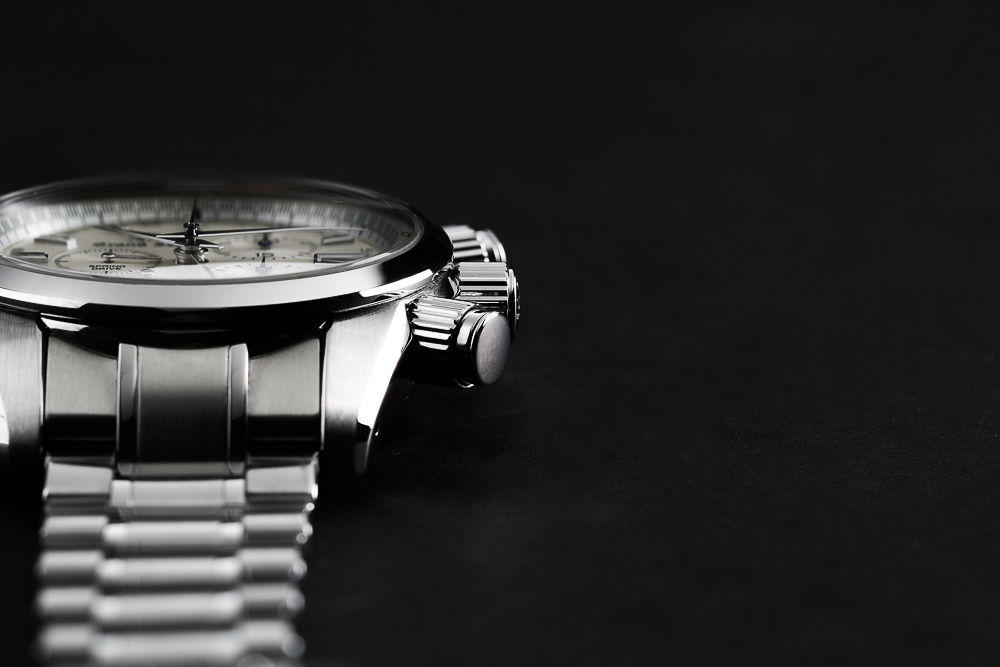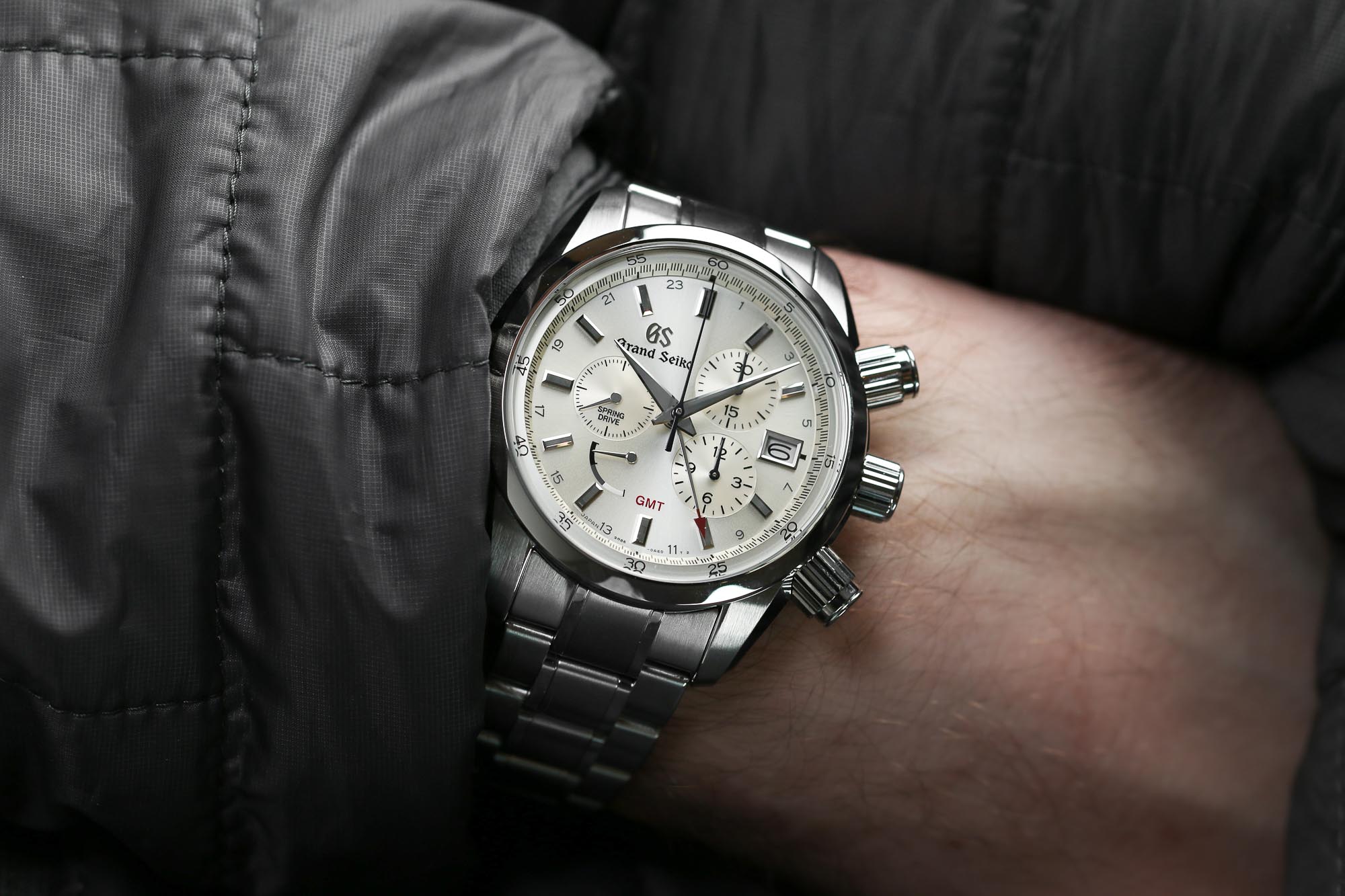
Without delving too deep into Spring Drive, let us review some of the basics. A Spring Drive movement operates largely in the same manner as a mechanical movement. It draws energy from a mainspring, not a battery. Additionally, power is transmitted through a gear train, just as it is in a traditional mechanical movement. In place of an escapement, however, Spring Drive features a Tri-Synchro regulator, which uses a combination of mechanical, electrical, and electromagnetic energy to regulate the movement and control the release of energy from the mainspring. In essence, Spring Drive takes the best elements from both mechanical watches (high torque and perpetual power source) and quartz watches (high precision and stability), while eliminating their inherent structural weaknesses, namely the escapement and battery, respectively.
With a power reserve of 72 hours and an accuracy rating of +-15 seconds per month (which extends to the elapsed time), caliber 9R86 may well be the world’s most accurate spring-driven chronograph. In addition to the chronograph feature, which can measure elapsed time up to 12 hours, Grand Seiko also included a GMT function, which allows the wearer to track an additional time zone. Architecturally, it is a complex caliber with over 400 parts and 50 jewels, and it is assembled entirely by hand, the task entrusted to a small number of qualified watchmakers at the Shinshu Watch Studio in Shiojiri, Nagano Prefecture in Japan.

Structurally, 9R86 features two important high-end features designed to maintain peak performance – a column wheel and a vertical clutch:

Column Wheel
A column wheel is an upright, rotating wheel (it almost looks like a castle turret) that operates the various levers that turn a chronograph on and off. A column wheel has a distinct, tactile feel when engaged, ensuring precise starts and stops of the mechanism that can be felt in hand (so much so, in fact, that you would not even need to look at the watch to know that the chronograph has started). The alternative, known as a cam-activated chronograph, often feels gummy and not as precise. Column wheels are not commonly seen in most chronograph movements today and are largely relegated to higher-end movements due to the expense and complexity involved in manufacturing them.
Image: column wheel

Vertical Clutch
A chronograph operates via the coupling of the chronograph and regular gear trains. A vertical clutch, which is used in 9R86, engages the chronograph seconds wheel with the running seconds wheel vertically by “dropping” the clutch instead of meshing gears horizontally. Though horizontal engagement is more common in chronographs today, it is not optimal for performance. For instance, the chronograph seconds will jump when starting a horizontal engagement, resulting in less precise measurement. Furthermore, the gears meshing together can cause them to stick, and misalignment of gears can result in increased wear and less clear-cut operation, so a vertical clutch, despite being harder to produce, is preferable.
Image: vertical clutch and column wheel assembly
Grand Seiko’s first chronograph was ref. SBGC001, designed by Shinichiro Kubo and unveiled in 2007. This was the reference number for the watch featured here before Grand Seiko became an independent brand in 2017 and unveiled SBGC201. Essentially, what we’re looking at today is the foundational Grand Seiko chronograph.

Let us first run through the specs. The case measures 43.5mm in diameter, 16.1mm in thickness, 51.2mm in length, and 21mm in lug width. On the bracelet, the watch weighs 187 grams. The topside crystal is a dual curve sapphire, and there’s a sapphire crystal on the case back for the display. The watch is rated to 100m of water resistance, and has a magnetic resistance rating of 4,8000 A/m, or 60 Gauss.

The stainless steel case features a beautiful mix of mirror-polished and hairline-finished surfaces. This is most immediately evident along the lugs and mid-case, where the top surface has a beautiful hairline finish while the facet along the mid-case is Zaratsu-polished to a distortion-free shine.
Despite the information-heavy dial, chronograph functionality is arranged in an incredibly legible way here. A thirty-minute register is positioned around two o’clock, a twelve-hour register below that at four, and an active seconds hand is placed at nine. Additionally, there is a power reserve indicator around seven.
Though it is an uncommon layout, having the two chronograph registers stack in a vertical line on the right side of the dial makes it very easy to read the elapsed time, even at a glance, as all the information is arranged along the same axis. Aiding in that legibility is the fact that the chronograph second hand is usually color matched to the hands on the two chronograph counters, putting extra emphasis on the function. The hands are tempered blue in the case of SBGC201, which offers notable contrast against the champagne sun-ray dial. (As is the case with all tempered Grand Seiko hands, these are done individually and not in batches.)

In order to create an easy-to-read measurement of up to 1/5th of a second, Grand Seiko’s designers determined the ideal distance between the tip of the seconds hand and the 1/5th marker on the dial – 0.15mm. Each second marker is also indented along the scale, making it very easy to differentiate from the other markings.
Another small element that aids in legibility is the way the 30-minute register shows elapsed time. Rather than slowly advancing over the course of a minute, the hand jumps at the end of each minute.

Inspired by the iconic 1964 Tokyo Olympics stopwatch, the screw down pushers on SBC201 are designed to be highly tactile and precise, much like they were with that original stopwatch. The pushers boast a “ready, set, go” feature, where they function much like a camera shutter. A user can depress the pushers halfway to brace for the start of the timing event, and then press down with a defined click for when the event begins. The result is greater timing precision. Despite being notably large, the pushers do not impact the comfort of the watch. The case geometry keeps the pushers off the wrist, which keeps them from digging into the skin when worn.

Caliber 9R86 is shown through the display case back. Finishing is, as one should come to expect with a Grand Seiko caliber, excellent. Grand Seiko’s distinct striping, called Line Gradation Stripes, is front and center. Additionally, the column wheel, as well as the gold-colored chronograph minutes and hours wheels, are made visible, too, allowing the user to view the chronograph mechanism in action. For fans of Spring Drive, the spinning Glide Wheel can also be seen.
SBGC201 is paired with a five-link stainless steel bracelet featuring a three-fold clasp with push button release. The bracelet offers a nice balance to the watch head both in terms of design and weight.
Price: $8,200
Case: Stainless Steel
Dimensions: 43.5mm diameter x 16.1mm thickness x 51.2mm length
Movement: Spring Drive Automatic Chronograph GMT 9R86
Availability: Grand Seiko Boutiques, Salons, and Mastershops